名词解释和问答题1
语音名词解释及简答题答案
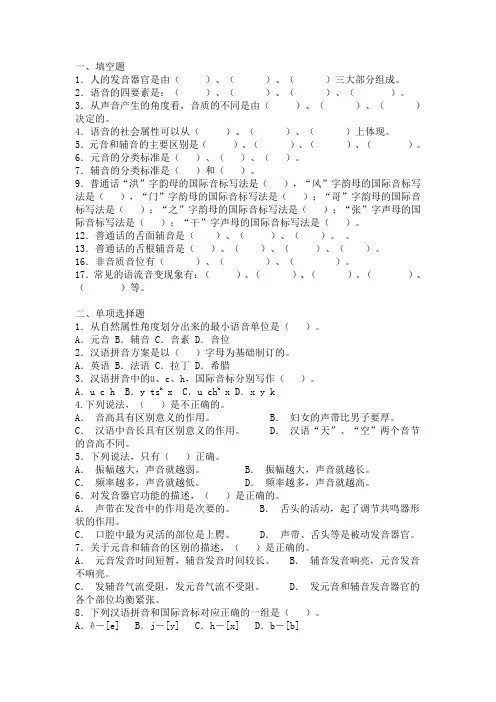
一、填空题1.人的发音器官是由()、()、()三大部分组成。
2.语音的四要素是:()、()、()、()。
3.从声音产生的角度看,音质的不同是由()、()、()决定的。
4.语音的社会属性可以从()、()、()上体现。
5.元音和辅音的主要区别是()、()、()、()。
6.元音的分类标准是()、()、()。
7.辅音的分类标准是()和()。
9.普通话“洪”字韵母的国际音标写法是(),“风”字韵母的国际音标写法是(),“门”字韵母的国际音标写法是();“哥”字韵母的国际音标写法是();“之”字韵母的国际音标写法是();“张”字声母的国际音标写法是();“干”字声母的国际音标写法是()。
12.普通话的舌面辅音是()、()、()。
13.普通话的舌根辅音是()、()、()、()。
16.非音质音位有()、()、()。
17.常见的语流音变现象有:()、()、()、()、()等。
二、单项选择题1.从自然属性角度划分出来的最小语音单位是()。
A.元音 B.辅音 C.音素 D.音位2.汉语拼音方案是以()字母为基础制订的。
A.英语 B.法语 C.拉丁 D.希腊3.汉语拼音中的ü、c、h,国际音标分别写作()。
A.u c h B.y ts h x C.u ch h x D.x y k4.下列说法,()是不正确的。
A.音高具有区别意义的作用。
B.妇女的声带比男子要厚。
C.汉语中音长具有区别意义的作用。
D.汉语“天”、“空”两个音节的音高不同。
5.下列说法,只有()正确。
A.振幅越大,声音就越弱。
B.振幅越大,声音就越长。
C.频率越多,声音就越低。
D.频率越多,声音就越高。
6.对发音器官功能的描述,()是正确的。
A.声带在发音中的作用是次要的。
B.舌头的活动,起了调节共鸣器形状的作用。
C.口腔中最为灵活的部位是上腭。
D.声带、舌头等是被动发音器官。
7.关于元音和辅音的区别的描述,()是正确的。
A.元音发音时间短暂,辅音发音时间较长。
分析化学每一章的名词解释和问答题
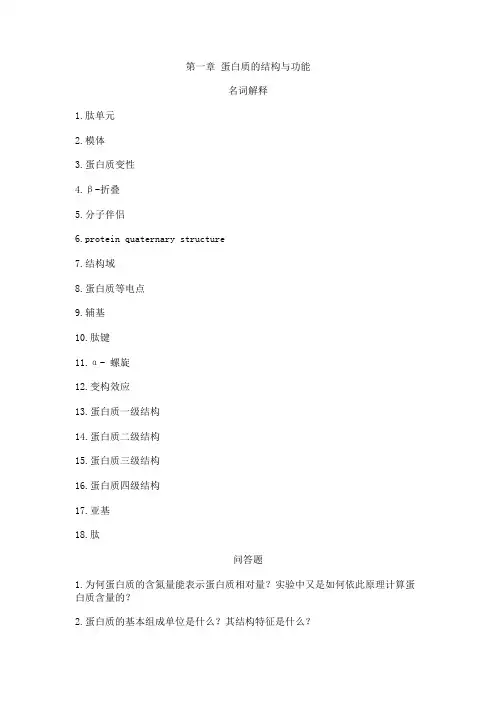
第一章蛋白质的结构与功能名词解释1.肽单元2.模体3.蛋白质变性4.β-折叠5.分子伴侣6.protein quaternary structure7.结构域8.蛋白质等电点9.辅基10.肽键11.α- 螺旋12.变构效应13.蛋白质一级结构14.蛋白质二级结构15.蛋白质三级结构16.蛋白质四级结构17.亚基18.肽问答题1.为何蛋白质的含氮量能表示蛋白质相对量?实验中又是如何依此原理计算蛋白质含量的?2.蛋白质的基本组成单位是什么?其结构特征是什么?3.何为氨基酸的等电点?如何计算精氨酸的等电点?(精氨酸的α- 羧基、α- 氨基和胍基的 pK 值分别为 2.17 , 9.04 和 12.48 )4.何谓肽键和肽链及蛋白质的一级结构?5.什么是蛋白质的二级结构?它主要有哪几种?各有何结构特征? 6 .举列说明蛋白质的四级结构。
7.已知核糖核酸酶分子中有 4 个二硫键,用尿素和β- 巯基乙醇使该酶变性后,其 4 个二硫键全部断裂。
在复性时,该酶 4 个二硫键由半胱氨酸随机配对产生,理论预期的正确配对率为 1 %,而实验结果观察到正确配对率为 95 %~100 %,为什么?8.什么是蛋白质变性?变性与沉淀的关系如何?9.举列说明蛋白质一级结构、空间构象与功能之间的关系。
10.举例说明蛋白质的变构效应。
11.常用的蛋白质分离纯化方法有哪几种?各自的作用原理是什么?12.测定蛋白质空间构象的主要方法是什么?其基本原理是什么?第二章核酸的结构与功能名词解释1.核小体2.碱基互补(碱基配对)3.脱氧核苷酸4.增色效应5.Tm值6.核糖体7.核酶8.核酸分子杂交9.TΨC 环10.反密码环11.Z-DNA12.核酸变性13.核酸复性问答题1.细胞内有哪几类主要的 RNA ?其主要功能是什么?2.用32P标记的病毒感染细胞后产生有标记的后代,而用35S标记的病毒感染细胞则不能产生有标记的后代,为什么?3.一种 DNA 分子含 40 %的腺嘌呤核苷酸,另一种 DNA 分子含 30 %的胞嘧啶核苷酸,请问哪一种 DNA 的 Tm 值高?为什么?4.已知人类细胞基因组的大小约 30 亿 bp ,试计算一个二倍体细胞中 DNA 的总长度,这么长的 DNA 分子是如何装配到直径只有几微米的细胞核内的?5.简述 DNA 双螺旋结构模式的要点及其与 DNA 生物学功能的关系。
语言学名词解释和问答题答案(只供参考)
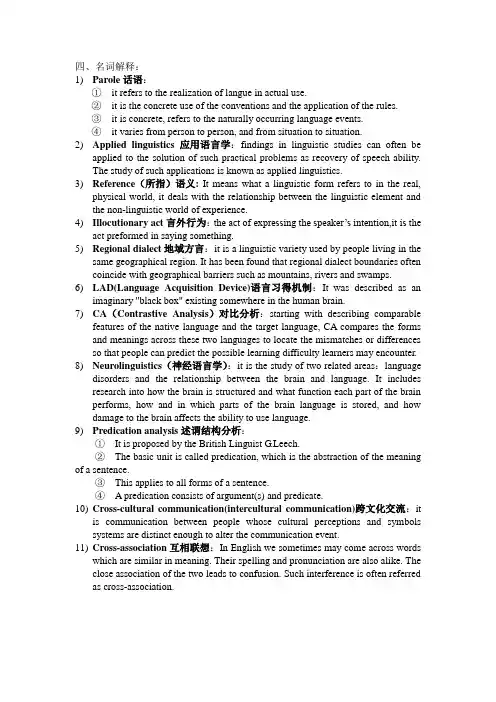
四、名词解释:1)Parole话语:①it refers to the realization of langue in actual use.②it is the concrete use of the conventions and the application of the rules.③it is concrete, refers to the naturally occurring language events.④it varies from person to person, and from situation to situation.2)Applied linguistics应用语言学:findings in linguistic studies can often beapplied to the solution of such practical problems as recovery of speech ability.The study of such applications is known as applied linguistics.3)Reference(所指)语义: It means what a linguistic form refers to in the real,physical world, it deals with the relationship between the linguistic element and the non-linguistic world of experience.4)Illocutionary act言外行为:the act of expressing the speaker’s intention,it is th eact preformed in saying something.5)Regional dialect地域方言:it is a linguistic variety used by people living in thesame geographical region. It has been found that regional dialect boundaries often coincide with geographical barriers such as mountains, rivers and swamps.6)LAD(Language Acquisition Device)语言习得机制:It was described as animaginary "black box" existing somewhere in the human brain.7)CA(Contrastive Analysis)对比分析:starting with describing comparablefeatures of the native language and the target language, CA compares the forms and meanings across these two languages to locate the mismatches or differences so that people can predict the possible learning difficulty learners may encounter.8)Neurolinguistics(神经语言学):it is the study of two related areas:languagedisorders and the relationship between the brain and language. It includes research into how the brain is structured and what function each part of the brain performs, how and in which parts of the brain language is stored, and how damage to the brain affects the ability to use language.9)Predication analysis述谓结构分析:①It is proposed by the British Linguist G.Leech.②The basic unit is called predication, which is the abstraction of the meaning of a sentence.③This applies to all forms of a sentence.④ A predication consists of argument(s) and predicate.10)Cross-cultural communication(intercultural communication)跨文化交流:itis communication between people whose cultural perceptions and symbols systems are distinct enough to alter the communication event.11)Cross-association互相联想:In English we sometimes may come across wordswhich are similar in meaning. Their spelling and pronunciation are also alike. The close association of the two leads to confusion. Such interference is often referred as cross-association.12)CPH(Critical Period Hypothesis)临界期假说:a specific and limited time period for language acquisition.①The strong version of CPH suggests that children must acquire their first language by puberty or they will never be able to learn from subsequent exposure.②The weak version holds that language learning will be more difficult and incomplete after puberty. (Support in Victor’s and Genie’s cases)13) Prescriptive(grammer)规定语法:if the linguistic study aims to lay down rules for "correct and standard " behaviour in using language to ell people what they should say and what they should not say, it is said to be prescriptive.14) Performance语言运用;言语行为:the actual realization of this knowledge in linguistic communication .15)Duality双重性(double articulation):language is a system, which consists of two sets of structures, or two levels. The lower or basic level is of sounds, which are meaningless. The higher level can be meaningful.五、问答题:Chapter 11.How do you interpret the following definition of linguistics: linguistics is the scientificstudy of language?Linguistics studies not any particular language,but it studies languages in general.It is a scientific study because it is based on the systematic investigation of linguistic data,conducted with reference to some general theory of language structure.In order to discover the nature and rules of the underlying language system, what the linguist has to do first is to collect and observe language facts,which are found to display some similarities ,and generalizations are made about them,then he formulates some hypotheses about the language structure .But the hypotheses thus formed have to be checked repeatedly against the observed facts to fully prove their validity.6. How is Saussure’s distinction between langue and parole similar to Chomsky’sdistinction between competence and performance?Both Saussure and Chomsky make the distinction between the abstract language system and the actual use of language. their purpose is to single out the language system for serious studyThey are similar in two aspects: the definition and the content of study.On one hand, Saussure defines langue as the abstract linguistic system shared by all themembers of a speech community, and parole as the realization of langue in actual use.Chomsky defines competence as the ideal user’s knowledge of the rules of his language, and performance the actual realization of this knowledge in linguistic communication. We can see that langue and competence both refer to the abstract issue, conventions and knowledge, and parole and performance both are their actual realization, the concrete use.On the other hand, in Saussure’s opinion, what linguists should do is to abstract langue from parole as parole is too varied and confusing. And this is the same as Chomsky. He thinkslinguists should study t he ideal speaker’s competence, not his performance, which is too haphazard to be studied.Two linguists idea differ in that Saussure took a sociological view of language, Chomsky looks at language from a psychological point of view, competence is a property of the mind of each individual.8.What are the main features of human language that have been specified by C.Hockettto show that it is essentially different from animal communication system?1)Arbitrariness:this means that there is no logical connection between meanings andsounds. A good example is the fact that different sounds are used to refer to the same object in different language.2)Productivity:Language is productive in that it makes possible the construction andinterpretation of new signals of its users.3)Duality:language is a system, which consists of two sets of structures, or two levels. Atthe lower or the basic level there is a structure of sounds, which are meaningless. But the sounds of language can be grouped and regrouped into a large number of units of meaning, which are found at the higher level of the system.4) Displacement: Language can be use to refer to things which are present or not present, realor imagined matters in the past ,present or future, or in far-away places. In other words, language can be used to refer to contexts removed from the immediate situations of the speaker.5) Cultural transmission:Language is passed on from one generation to next through teachingand learning rather than by instinct.Chapter 23.Explain with examples how broad transcription and narrow one transcription differ? Broad transcription—one letter symbol for one sound.Narrow transcription—diacritics are added to the one-letter symbols to show the finer differences between sounds.In broad transcription, the symbol [l] is used for the sound [l]8.what’s a phone? how is it different from a phoneme? how are allophones related to a phoneme?① A phone is a phonetic unit or segment. The speech sounds we hear and produce during linguistic communication are all phones. Phones do not necessarily distinguish meaning, some do, some don’t, e.g. [ bI:t ] & [ bIt ], [spIt] & [spIt].② A phoneme is a phonological unit; it is a unit of distinctive value; an abstract unit, not a particular sound, but it is represented by a certain phone in certain phonetic context, e.g. the phoneme /p/ can be represented differently in [pIt], [tIp] and [spIt].③Allophone—the phones that can represent a phoneme in different phonetic environmentsPhone is different from phoneme,The phoneme /l/ can be realized as dark/l-/and clear/l/,which are allophones of the phoneme /l/1.What are the major views concerning the study of meaning?1)The naming theory命名论was proposed by the ancient Greek scholar Plato. Thelinguistic forms or symbols, in other words, the words used in a language are taken to be labels of the objects they stand for; words are just names or labels for things. The semantic relationship holding between words and things is the relationship of naming.2)The conceptualist view概念论: This view holds that there is no direct link between alinguistic form and what it refers to; rather, in the interpretation of meaning they are linked through the mediation of concepts in the mind. This is best illustrated by the semantic triangle suggested by Ogden and Richards:3)Contextualism语境论: Representatively proposed by the British linguist J. R. Firthwho had been influenced by the Polish anthropologist Malinowski and the German philosopher Wittgenstein.It holds that meaning should be studied in terms of situation, use, context-elements closely linked with language behavior. …the meaning of a word is its use in the language.4)Behaviourism行为主义论: Based on contextualist view by Bloomfield who drew onbehaviorist psychology in defining “meaning”.Behaviorists attempted to define the meaning of a language from as the “situation in which the speaker utters it and the response it calls forth in the hearer.” This theory, somewhat close to contextualism, is linked with psychological interest.6.In what way is componential analysis similar to the analysis of phonemes into distinctive features?成分分析和把音位分析为区别性特征有何相似之处?In the light of componential analysis, the meaning of a word consists of a number of distinctive meaning features, the analysis breaks down the meaning of the word into these features; it is these different features that distinguish word meaning similarly, a phoneme is considered as a collection of distinctive sound features, a phoneme can be broken down into these distinctive sound features and its these sound features that distinguish different sounds.5. According to Austin, what are the three acts a person is possibly performing while making an utterance. Give an example.According to Austin's new model, a speaker might be performing three acts simultaneously when speaking: locutionary act, illocutionary act, and perlocutionary act.A locutionary act is the act of uttering words, phrases, clauses. It is the act of conveying literal meaning by means of syntax, lexicon and phonology. An illocutionary act is the act of expressing the speaker’s intention; it is the act performed in saying something. A perlocutionary act is the act performed by or resulting from saying something; it is the consequence of, or the change brought about by the utterance; it is the act performed by saying something. Let's look at an example:"You have left the door wide open."The locutionary act performed by the speaker is his utterance of the wo rds “you”, “have”, “door”,“open”, etc. thus expressing what the words literally mean.The illocutionary act performed by the speaker is that by making such an utterance he has expressed his intention of speaking, i.e. asking someone to close the door, or making a complaint, depending on the context.The perlocutionary act refers to the effect of the utterance. If the hearer gets the speaker's message and sees that the speaker means to tell him to close the door, the speaker has successfully brought about the change in the real world he has intended to; then the perlocutionary act is successfully performed.8. What are the four maxims of the CP? Try to give your own examples to show how floutingthese maxims gives rise to conversational implicature?答:Cooperative Principle, abbreviated as CP. It goes as follows:Make your conversational contribution such as required at the stage at which it occurs by the accepted purpose or direction of the talk exchange in which you are engaged.To be more specific, there are four maxims under this general principle:(1) The maxim of quantity数量原则E.g. A: When is Susan's farewell party?B: Sometimes next month.It is flouting the maxim of quantity(2) The maxim of quality质量原则E.g. A: Would you like to join us for the picnic on Sunday?B: I'm afraid I have got a class on Sunday.(3) The maxim of relation相关原则E.g. A: How did the math exam go today, Tom?B: We had a basketball match with the other class.(4) The maxim of manner方式准则E.g. A: Shall we got something for the kids?B: Yes. But I veto I-C-E-C-R-E-A-M.Chapter92.What do you think of Sapir-Whorf hypothesis? Give examples or proof to support your point of view.Sapir-Whorf believe that language filters people's perception and the way they categorize their experiences. This interdependence of language and thought is now known as Sapir-Whorf Hypothesis. There are mainly two different interpretations about Sapir-Whorf Hypothesis: a strong version and a weak one. The strong version believes that language patterns determine people’s thinking and behavior, the weak one holds that the former influences the later.I agree with the weak one. Here is an example, the word snow. For Eskimo snow is extremely important and so crucial to life that each of its various forms and conditions is named. In English-speaking cultures, snow is far less important and simple word snow usually suffices the need. When some needs become more specific, however, longer phrases can be made up to meet these needs: “corn snow”, “fine powder snow”, and “drifting snow”.Chapter102.Among the language acquisition theories mentioned in this chapter, which one do you think is more reasonable and convincing? Explain why.1)Behaviourist view---language is behavior ,language learning is simply a matter of imitation and habit formation.In this theory,imitation and practice are preliminary(开始),discrimination (识别)and generalizaition are key to language development.2)An innatist (语法天生主义者)view----In the human brain, there is an imaginary “black box”called Language acquisition device which is said to contain principles that are universal to all language.Children need access to the samples of a natural language to activate the LAD, which enables them to discover his language's structure by matching the innate knowledge of basic grammatical system to that particular ter Chomsky prefer this innate endowment as UG and hold that if children are pre-equipped with UG, then what they have to learn is the ways in which their own language make use of these principles and the variations in those principles which may exist in the particular language they are learning.3) An interactionist(互动主义者)view----language develops as a result of the complex interplay,between the human characteristics of the child and the environment in which child develops.In a word,Behaviorists view sounds reasonable in explaining the routine aspects,the innatist accounts most reasonable in explaining children's acquiring complex system, and the interactionist description convincing in understanding how children learn and use the language appropriately from their environment.Chapter111、To what extent is second language learning similar to first language learning? Can you list some proof from your own learning experience?(please list your own experience.)The studies on the first language acquisition have influenced enormously those on the second language acquisition at both theoretical and pratical levels. Theoretically the new findings and advances in first language acquisition in learning theories and learning process are illuminating in understanding second language acquisition. The techniques used to collect and analyze data in first language acquisition also provide insights and perspectives in the study of second language acquisition. Just as Littlewood summarizes, the first language study has served as a backcloth for perceiving and undrerstanding new facts about second language learning.2.Try to observe yourself and pay attention to your own learning experience, what conclusion can you reach about the role of Chinese in your English learning? On what occasions are you more likely to use or depend on Chinese in learning and using English? Chinese plays an inseparable role in our English learning and people can't afford to ignore it. Hence, the role of Chinese in our English learning is worth careful examination. In addition, English learning have been influnenced by Chinese learning at both theoretical and practical levels.(1)Theoretically, the new findings and advanced in Chinese acquisition especially in learning theories and learning process are illuminate (helping) in understanding English acquisition.(2)The techniques used to collect and analyze data in Chinese learning also provides insights and perspectives in the study of English learning.Occasion: Recent studies have discovered that there are three interacting factors in determining language transfer in second language learning:1)a learner's psychology, how a learner organizes his or her native language;2)a learner's perception of native-target language distance,3)a learner's actual knowledge of the target language.。
一、名词解释(每题3分,共30分)
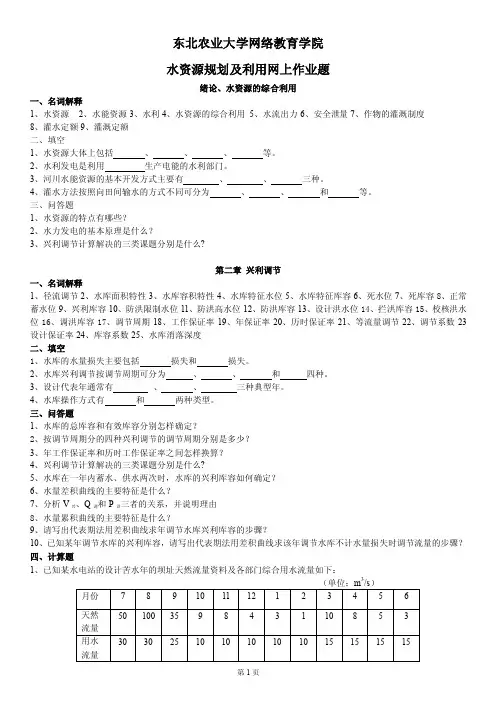
东北农业大学网络教育学院水资源规划及利用网上作业题绪论、水资源的综合利用一、名词解释1、水资源2、水能资源3、水利4、水资源的综合利用5、水流出力6、安全泄量7、作物的灌溉制度8、灌水定额9、灌溉定额二、填空1、水资源大体上包括、、、等。
2、水利发电是利用生产电能的水利部门。
3、河川水能资源的基本开发方式主要有、、三种。
4、灌水方法按照向田间输水的方式不同可分为、、和等。
三、问答题1、水资源的特点有哪些?2、水力发电的基本原理是什么?3、兴利调节计算解决的三类课题分别是什么?第二章兴利调节一、名词解释1、径流调节2、水库面积特性3、水库容积特性4、水库特征水位5、水库特征库容6、死水位7、死库容8、正常蓄水位9、兴利库容10、防洪限制水位11、防洪高水位12、防洪库容13、设计洪水位14、拦洪库容15、校核洪水位16、调洪库容17、调节周期18、工作保证率19、年保证率20、历时保证率21、等流量调节22、调节系数23设计保证率24、库容系数25、水库消落深度二、填空1、水库的水量损失主要包括损失和损失。
2、水库兴利调节按调节周期可分为、、和四种。
3、设计代表年通常有、、三种典型年。
4、水库操作方式有和两种类型。
三、问答题1、水库的总库容和有效库容分别怎样确定?2、按调节周期分的四种兴利调节的调节周期分别是多少?3、年工作保证率和历时工作保证率之间怎样换算?4、兴利调节计算解决的三类课题分别是什么?5、水库在一年内蓄水、供水两次时,水库的兴利库容如何确定?6、水量差积曲线的主要特征是什么?7、分析V兴、Q调和P设三者的关系,并说明理由8、水量累积曲线的主要特征是什么?9、请写出代表期法用差积曲线求年调节水库兴利库容的步骤?10、已知某年调节水库的兴利库容,请写出代表期法用差积曲线求该年调节水库不计水量损失时调节流量的步骤?四、计算题1、已知某水电站的设计苦水年的坝址天然流量资料及各部门综合用水流量如下:3坝址处的多年平均径流量为1100.5×106m 3。
生理学名词解释问答题
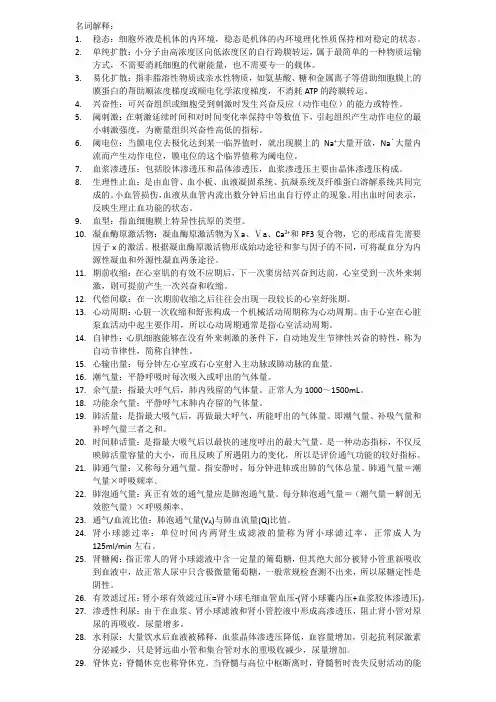
名词解释:1.稳态:细胞外液是机体的内环境,稳态是机体的内环境理化性质保持相对稳定的状态。
2.单纯扩散:小分子由高浓度区向低浓度区的自行跨膜转运,属于最简单的一种物质运输方式,不需要消耗细胞的代谢能量,也不需要专一的载体。
3.易化扩散:指非脂溶性物质或亲水性物质,如氨基酸、糖和金属离子等借助细胞膜上的膜蛋白的帮助顺浓度梯度或顺电化学浓度梯度,不消耗ATP的跨膜转运。
4.兴奋性:可兴奋组织或细胞受到刺激时发生兴奋反应(动作电位)的能力或特性。
5.阈刺激:在刺激延续时间和对时间变化率保持中等数值下,引起组织产生动作电位的最小刺激强度,为衡量组织兴奋性高低的指标。
6.阈电位:当膜电位去极化达到某一临界值时,就出现膜上的Na+大量开放,Na﹢大量内流而产生动作电位,膜电位的这个临界值称为阈电位。
7.血浆渗透压:包括胶体渗透压和晶体渗透压,血浆渗透压主要由晶体渗透压构成。
8.生理性止血:是由血管、血小板、血液凝固系统、抗凝系统及纤维蛋白溶解系统共同完成的。
小血管损伤,血液从血管内流出数分钟后出血自行停止的现象。
用出血时间表示,反映生理止血功能的状态。
9.血型:指血细胞膜上特异性抗原的类型。
10.凝血酶原激活物:凝血酶原激活物为Ⅹa、Ⅴa、Ca2+和PF3复合物,它的形成首先需要因子x的激活。
根据凝血酶原激活物形成始动途径和参与因子的不同,可将凝血分为内源性凝血和外源性凝血两条途径。
11.期前收缩:在心室肌的有效不应期后,下一次窦房结兴奋到达前,心室受到一次外来刺激,则可提前产生一次兴奋和收缩。
12.代偿间歇:在一次期前收缩之后往往会出现一段较长的心室舒张期。
13.心动周期:心脏一次收缩和舒张构成一个机械活动周期称为心动周期。
由于心室在心脏泵血活动中起主要作用,所以心动周期通常是指心室活动周期。
14.自律性:心肌细胞能够在没有外来刺激的条件下,自动地发生节律性兴奋的特性,称为自动节律性,简称自律性。
15.心输出量:每分钟左心室或右心室射入主动脉或肺动脉的血量。
药理学名词解释及大题
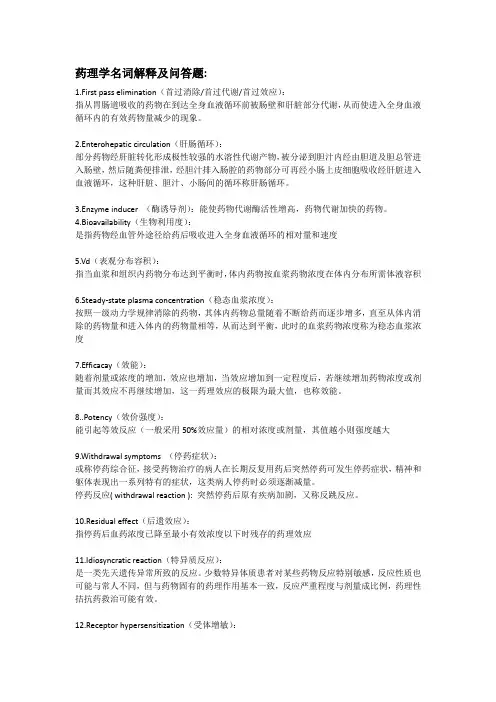
药理学名词解释及问答题:1.First pass elimination(首过消除/首过代谢/首过效应):指从胃肠道吸收的药物在到达全身血液循环前被肠壁和肝脏部分代谢,从而使进入全身血液循环内的有效药物量减少的现象。
2.Enterohepatic circulation(肝肠循环):部分药物经肝脏转化形成极性较强的水溶性代谢产物,被分泌到胆汁内经由胆道及胆总管进入肠壁,然后随粪便排泄,经胆汁排入肠腔的药物部分可再经小肠上皮细胞吸收经肝脏进入血液循环,这种肝脏、胆汁、小肠间的循环称肝肠循环。
3.Enzyme inducer (酶诱导剂):能使药物代谢酶活性增高,药物代谢加快的药物。
4.Bioavailability(生物利用度):是指药物经血管外途径给药后吸收进入全身血液循环的相对量和速度5.Vd(表观分布容积):指当血浆和组织内药物分布达到平衡时,体内药物按血浆药物浓度在体内分布所需体液容积6.Steady-state plasma concentration(稳态血浆浓度):按照一级动力学规律消除的药物,其体内药物总量随着不断给药而逐步增多,直至从体内消除的药物量和进入体内的药物量相等,从而达到平衡,此时的血浆药物浓度称为稳态血浆浓度7.Efficacay(效能):随着剂量或浓度的增加,效应也增加,当效应增加到一定程度后,若继续增加药物浓度或剂量而其效应不再继续增加,这一药理效应的极限为最大值,也称效能。
8..Potency(效价强度):能引起等效反应(一般采用50%效应量)的相对浓度或剂量,其值越小则强度越大9.Withdrawal symptoms (停药症状):或称停药综合征,接受药物治疗的病人在长期反复用药后突然停药可发生停药症状,精神和躯体表现出一系列特有的症状,这类病人停药时必须逐渐减量。
停药反应( withdrawal reaction ): 突然停药后原有疾病加剧,又称反跳反应。
《环境卫生学》各章节名词解释与问答题
第一章绪论一、名词解释1、环境卫生学6、一次污染物2、环境介质7、二次污染物3、环境因素8、原生环境4、持久性有机污染物9、次生环境5、内分泌干扰物10、生物地球化学性疾病11、生物多样性13、可持续发展12、清洁生产二、问答题1、简述人与环境的辨证统一关系。
2、简述环境卫生和环境卫生工作之间的联系和区别。
第二章环境与健康的关系一、名词解释1.生态环境(ecological environment)2.生态系统(ecosystem)3.生态系统服务(ecosystem service)4.环境与人体的生态平衡5.生物放大作用(biomagnification)6.二次污染物(secondary pollutant)7.一次污染物(primary pollutant)8.剂量-反应关系(dose-response relationship) 9.联合毒性作用(joint toxic effect)10.相加作用(additive effect)11.协同作用(synergistic effect)12.增强作用(potentiation)13.拮抗作用(antagonism)14.健康效应谱(spectrum of health effect)15.易感人群(susceptible group)16.环境应答基因(environmental response gene) 17.必需微量元素(essential trace element)18.生物地球化学性疾病(biogeochemical disease) 19.环境污染(environmental pollution)20.持久性有机污染物(persistent organic pollutants)21.先天畸形(congenital malformation)22.胚胎毒性(embryotoxicity)23.环境内分泌干扰物(environmental endocrine disrupting chemicals)24.内剂量(internal dose)25.生物有效剂量(biologically effective dose)26.高危人群(high risk group)27.生物标志(biomarker)28.健康危险度评价(health risk assessment)29.致癌强度系数(carcinogenic potency factor)二、问答题1.人体对环境的适应在维持人类的生存和健康上有何意义?2.什么是环境物质的迁移和转化作用?环境污染物在环境介质中发生的迁移和转化对环境因素的暴露会产生哪些影响?举例说明。
中医基础理论名词解释及问答题
中医基础理论名词解释及问答题第一、二章结论与阴阳五行名词解释1、整体观念2、证3、辨证治疗4、同病异治5、异病同治6、阴阳7、阴平阳秘8、阴血9、阳气10、阳胜则热11、阳胜则阴病12、阴胜则寒13、阴胜则阳病14、阳虚则寒15、阴虚则热16、重阴必阳17、重阳必阴18、阴损及阳19、阳损及阴20、热者寒之21、寒者热之22、阳病治阴23、阴病治阳24、五行25、五气26、五色27、五志28、五味29、五季30、五官31、五体32、五液33、相生34、相克35、相乘36、相侮37、制化38、母病及子39、子病犯母40、子盗母气41、虚则补其母42、实则泻其子43、滋水涵木44、益火补土45、培土生金46、金水相生47、抑木扶土48、培土制水49、佐金平木50、泻南补北问答题(一)简答题(只答要点,不必展开。
以下同)1、中医学的“整体观念”思想主要有哪些内容?2、什么是中医学的辨证论治?3、简述阴阳五行学说的中心思想。
4、简述阴阳学说的基本内容。
5、怎样理解“阴在内,阳之地也;阳在外,阴之使也”?6、怎样理解“阳病治阴,阴病治阳”?7、既然五脏属阴,六腑属阳,为什么又说心肺属阳?8、简述五行的特性。
9、什么叫五行的生克乘侮,其顺序如何?10、五行学说在诊断和治疗上的应用如何?(二)轮述题(除答出要点外,还要求展开论述。
以下同)1、试用阴阳学说说明人体的病理变化?2、阴阳学说如何指导疾病的治疗?3、试用五行学说说明五脏之间的生理联系。
4、试用五行学说说明五脏之间的病理影响。
第三章藏象名词解释1、藏象2、藏象学说3、脏腑4、五脏5、六腑6、奇恒之府7、神8、血府9、汗血同源10、津血同源11、1肺朝百脉12、肺主治节13、肺主行水14、通调水道15、肺为水之上源16、气门7、肺为娇脏18、肺主宣发和肃降19、脾主运化20、脾胃为后天之本21、肾为先天之本22、先天之精23、后天之精24、天癸25、元阴26、元阳27、肾者,胃之关也28、髓海29、七冲门30、中精之府31、水谷之海32、三焦气化33、心肾相交34、心肾不交35、脾为生痰之源,肺为贮痰之器36、肺为气之主,肾为气之根37、精血同源38、水气凌心。
病理学名词解释及问答题总结(第一章)
病理学名词解释及问答题总结(第一章)细胞和组织的适应与损伤*病理学(pathology)是研究疾病的病因、发病机制、病理变化、结局和转归的医学基础学科。
*适应(adaptation) 细胞和由其构成的组织、器官,对内外环境中各种有害因子和刺激作用而产生的非损伤性应答反应,形态学上表现为萎缩、肥大、增生、化生*Atrophy(萎缩)已发育正常的细胞、组织或器官体积缩小,包括实质细胞的体积缩小和数量减少*Hypertrophy(肥大)由于功能增加,合成代谢旺盛,使细胞、组织或器官体积增大,包括实质细胞体积增大、常伴数量增加*pseudo hypertrophy (假性肥大) 实质细胞萎缩的同时,间质细胞增生,以维持器官的体积,甚至造成器官组织的体积增大*hyperplasia (增生) 组织或器官内实质细胞数目增多,常导致体积增大*metaplasia(化生) 一种分化成熟的细胞类型被另一种分化成熟的细胞所取代的过程;不可能发生于神经纤维组织*squamous metaplasia (鳞状上皮化生) 慢支时,支气管纤毛柱状上皮被鳞状上皮取代的过程*intestinal metaplasia (肠上皮化生) 慢性胃炎时,胃粘膜上皮转化为含有潘氏细胞或杯状细胞的小肠或大肠上皮组织*degeneration (变性) 又称可逆性损伤,是指细胞或间质受损伤后,由于代谢障碍,导致细胞内或间质内出现异常物质或正常物质异常蓄积的现象,常伴细胞功能低下。
*cellular swelling (细胞水肿) 又称水变性,是细胞损伤时最早出现的改变。
系因线粒体受损,ATP生成减少,Na-K泵功能障碍,导致细胞内Na-K过多。
无机盐、乳酸等蓄积,导致渗透压升高,加重水肿*fatty degeneration or fatty change (脂肪变性) 中性脂肪特别是甘油三脂蓄积于非脂肪细胞中*tigroid heart (虎斑心)心肌脂肪变性时,脂肪心肌呈黄色,与正常心肌的暗红色相间,形成黄红色斑纹*myocardial fatty infiltration (心肌脂肪浸润) 心外膜增生的脂肪组织沿间质深入心肌细胞间*hyaline degeneration (透明变性) 又称玻璃样变hyalinization,细胞内或间质中出现半透明状蛋白质蓄积,HE染色呈嗜依红均质状;Rusell小体由于粗面内质网中免疫球蛋白蓄积而形成。
(整理)分析化学每一章的名词解释和问答题.
第一章蛋白质的结构与功能名词解释1.肽单元2.模体3.蛋白质变性4.β-折叠5.分子伴侣6.protein quaternary structure7.结构域8.蛋白质等电点9.辅基10.肽键11.α- 螺旋12.变构效应13.蛋白质一级结构14.蛋白质二级结构15.蛋白质三级结构16.蛋白质四级结构17.亚基18.肽问答题1.为何蛋白质的含氮量能表示蛋白质相对量?实验中又是如何依此原理计算蛋白质含量的?2.蛋白质的基本组成单位是什么?其结构特征是什么?3.何为氨基酸的等电点?如何计算精氨酸的等电点?(精氨酸的α- 羧基、α- 氨基和胍基的 pK 值分别为 2.17 , 9.04 和 12.48 )4.何谓肽键和肽链及蛋白质的一级结构?5.什么是蛋白质的二级结构?它主要有哪几种?各有何结构特征? 6 .举列说明蛋白质的四级结构。
7.已知核糖核酸酶分子中有 4 个二硫键,用尿素和β- 巯基乙醇使该酶变性后,其 4 个二硫键全部断裂。
在复性时,该酶 4 个二硫键由半胱氨酸随机配对产生,理论预期的正确配对率为 1 %,而实验结果观察到正确配对率为 95 %~100 %,为什么?8.什么是蛋白质变性?变性与沉淀的关系如何?9.举列说明蛋白质一级结构、空间构象与功能之间的关系。
10.举例说明蛋白质的变构效应。
11.常用的蛋白质分离纯化方法有哪几种?各自的作用原理是什么?12.测定蛋白质空间构象的主要方法是什么?其基本原理是什么?第二章核酸的结构与功能名词解释1.核小体2.碱基互补(碱基配对)3.脱氧核苷酸4.增色效应5.Tm值6.核糖体7.核酶8.核酸分子杂交9.TΨC 环10.反密码环11.Z-DNA12.核酸变性13.核酸复性问答题1.细胞内有哪几类主要的 RNA ?其主要功能是什么?2.用32P标记的病毒感染细胞后产生有标记的后代,而用35S标记的病毒感染细胞则不能产生有标记的后代,为什么?3.一种 DNA 分子含 40 %的腺嘌呤核苷酸,另一种 DNA 分子含 30 %的胞嘧啶核苷酸,请问哪一种 DNA 的 Tm 值高?为什么?4.已知人类细胞基因组的大小约 30 亿 bp ,试计算一个二倍体细胞中 DNA 的总长度,这么长的 DNA 分子是如何装配到直径只有几微米的细胞核内的?5.简述 DNA 双螺旋结构模式的要点及其与 DNA 生物学功能的关系。
- 1、下载文档前请自行甄别文档内容的完整性,平台不提供额外的编辑、内容补充、找答案等附加服务。
- 2、"仅部分预览"的文档,不可在线预览部分如存在完整性等问题,可反馈申请退款(可完整预览的文档不适用该条件!)。
- 3、如文档侵犯您的权益,请联系客服反馈,我们会尽快为您处理(人工客服工作时间:9:00-18:30)。
名词解释和问答题1四名词解释:1.原语:它是由若干条机器指令所构成,用以完成特定功能的一段程序,为保证其操作的正确性,它应当是原子操作,即原语是一个不可分割的操作。
2.设备独立性:指用户设备独立于所使用的具体物理设备。
即在用户程序中要执行I/O操作时,只需用逻辑设备名提出I/O请求,而不必局限于某特定的物理设备。
3.文件的逻辑结构:又称为文件逻辑组织,是指从用户观点看到的文件组织形式。
它可分为两类:记录式文件结构,由若干相关的记录构成;流式文件结构,由字符流构成。
4.树形结构目录:利用树形结构的形式,描述各目录之间的关系。
上级目录与相邻下级目录的关系是1对n。
树形结构目录能够较好地满足用户和系统的要求。
5.操作系统:操作系统是控制和管理计算机硬件和软件资源,合理地组织计算机的工作流程,以及方便用户的程序的集合。
其主要功能是实现处理机管理、内存管理、I/O设备管理、文件管理和用户接口。
6.位示图:它是利用一个向量来描述自由块使用情况的一张表。
表中的每个元素表示一个盘块的使用情况,0表示该块为空闲块,1表示已分配。
7.置换策略:虚拟式存储管理中的一种策略。
用于确定应选择内存中的哪一页(段) 换出到磁盘对换区,以便腾出内存。
通常采用的置换算法都是基于把那些在最近的将来,最少可能被访问的页(段)从内存换出到盘上。
8.用户接口:操作系统提供给用户和编程人员的界面和接口。
包括程序接口、命令行方式和图形用户界面。
9.死锁:指多个进程因竞争资源二造成的一种僵局,若无外力的作用,这些进程将永远不能再向前推进。
10.文件系统:OS中负责管理和存取文件信息的软件机构。
负责文件的建立,撤消,存入,续写,修改和复制,还负责完成对文件的按名存取和进行存取控制。
11.进程:进程是程序在一个数据集合上的运行过程,是系统进行资源分配和调度的一个独立的基本单位。
12.wait(s)原语wait(s) :BeginLock out interrupts;s = s – 1;If s < 0 then BeginStatus(q) = blocked;Insert(WL, q);Unlock interrupts; Scheduler;EndElse unlock interrupts;End13.链接文件逻辑文件中的不同记录可以存储在离散的磁盘块中。
每个盘块中都设置了一个指向下一个盘块的链接指针,用这些指针可将一个文件中的所有盘块拉成一条链,而在文件控制块中的“文件地址指针”便指向存放该文件的第一个盘块的编号。
14.快表采用联想存储器加快查表速度 ,在地址变换机构中,加入一个高速,小容量、具有并行查询能力的联想存储器,构成快表,存放正运行的作业的当前页号和块号。
在快表中找到,直接进行地址转换;未找到,则在主存页表继续查找,并把查到的页号和块号放入联想存储器的空闲单元中,如没有,淘汰最先装入的页号。
15.虚拟存储器指具有请求调入功能和置换功能,能从逻辑上对内存容量进行扩充的一种存储器系统。
从用户观点看,虚拟存储器具有比实际内存大得多的容量。
这既方便了用户,又提高了内存的利用率和系统的吞吐量。
16.文件目录为了向用户提供对文件的存取控制及保护功能,而按一定规则对系统中的文件名,(亦可包含文件属性)进行组织所形成的表,称为目录表或文件目录。
17.I/O控制:我们把从用户进程的输入/输出请求开始,给用户进程分配设备和启动有关设备进行I /O操作,以及在I /O 操作完成之后响应中断,进行善后处理为止的整个系统控制过程称为I /O 控制。
18. 缓冲池:这是具有多个缓冲区的公用缓冲器,其中的各个缓冲区可供多个进程或设备共享。
为便于管理,通常把缓冲池中的缓冲区,按其性质的不同而构成若干个链表或队列,如空缓冲队列,输入缓冲队列等。
19. SPOOLING:即同时联机外围操作,又称脱机操作。
在多道程序环境下,可利用多道程序中的一道程序,来模拟脱机的输入输出功能。
即在联机条件下,将数据从输入设备传送到磁盘,或从磁盘传送到输出设备。
20.逻辑地址与物理地址:在具有地址变换机构的计算机中,允许程序中编排的地址和信息实际存放在内存中的地址有所不同。
逻辑地址是指用户程序经编译后,每个目标模块以0为基地址进行的顺序编址。
逻辑地址又称相对地址。
物理地址是指内存中各物理存储单元的地址从统一的基地址进行的顺序编址。
物理地址又称绝对地址,它是数据在内存中的实际存储地址。
21虚拟存储器:答:虚拟存储器是一种存储管理技术,用以完成用小的内存实现在大的虚空间中程序的运行工作。
它是由操作系统提供的一个假想的特大存储器。
但是虚拟存储器的容量并不是无限的,它由计算机的地址结构长度所确定,另外虚存容量的扩大是以牺牲CPU工作时间以及内、外存交换时间为代价的。
22.PCB:23.联想存储器:24.设备独立性:25.系统调用:26.设备驱动程序:五问答题1.在单处理机环境下,进程间有哪几种通信方式,是如何实现的?1. 作业调度:从一批后备作业中选择一个或几个作业,给它们分配资源,建立进程,挂入就绪队列。
执行完后,回收资源。
进程调度:从就绪进程队列中根据某个策略选取一个进程,使之占用CPU。
交换调度:按照给定的原则和策略,将外存交换区中的进程调入内存,把内存中的非执行进程交换到外存交换区中。
2.设备管理中的数据传送控制方式有哪几种?分别简述如何实现的。
2. 程序直接控制:由用户进程来直接控制内存或CPU和外设间的信息传送。
中断方式:进程通过CPU发出指令启动外设,该进程阻塞。
当输入完成时,I/O控制器通过中断请求线向CPU发出中断信号,CPU进行中断处理。
DMA方式:在外设和内存之间开辟直接的数据交换通路。
通道控制方式:CPU发出启动指令,指出通道相应的操作和I/O 设备,该指令就可启动通道并使该通道从内存中调出相应的通道指令执行。
3.简述进程的几种状态和引起状态转换的典型原因,以及相关的操作原语。
3. 进程的基本状态有:新、就绪,阻塞,执行、挂起和终止六种。
新到就绪:交换,创建原语就绪到执行:进程调度执行到阻塞:I/O请求,阻塞原语阻塞到就绪:I/O完成,唤醒原语执行到就绪:时间片完阻塞到挂起:挂起原语挂起到就绪:唤醒原语执行到终止:进程执行完毕4.什么是段式存储管理?它从逻辑地址到物理地址是怎么变换的?4.把程序按内容或构成关系分成段,每段有自己的名字。
一个用户作业或进程包含的段对应于一个二维虚拟储存器。
以段为单位分配内存,然后通过地址映射机构把逻辑地址转换成物理地址。
只将那些经常访问的段驻留内存,其他的段放在外存,待需要时自动调入。
地址变换过程:由虚地址中的段号为索引,查段表。
找出该段在内存的起始地址,并将其和段内地址相加,从而得到物理地址。
5.什么是请求页式管理?能满足用户哪些需要?答:请求页式管理的基本原理是将逻辑地址空间分成大小相同的页,将存储地址空间分块,页和块的大小相等,通过页表进行管理。
页式系统的逻辑地址分为页号和页内位移量。
页表包括页号和块号数据项,它们一一对应。
根据逻辑空间的页号,查找页表对应项找到对应的块号,块号乘以块长,加上位移量就形成存储空间的物理地址。
每个作业的逻辑地址空间是连续的,重定位到内存空间后就不一定连续了。
此外,页表中还包括特征位(指示该页面是否在内存中)、外存地址、修改位(该页的内容在内存中是否修改过)等。
页式存储管理在动态地址转换过程中需要确定某一页是否已经调入主存。
若调入主存,则可直接将虚地址转换为实地址,如果该页未调入主存,则产生缺页中断,以装入所需的页。
页式存储管理将不常用的页面调出内存,使内存的利用率高;虚拟的容量大,用户不必担心内存不够;不要求作业连续存放,有效地解决了“碎片”问题。
6.在段页式虚拟存储系统中,不同进程之间是如何实现程序共享的?6.在系统内设置有系统段表,用户段表指向系统段表,系统段表内有当前共享的用户数。
当用户进程调入一个程序段之前,先查找系统段表,如果所需段存在,则将共享用户数加一,在将此段登记在用户进程段表中。
当进程退出时,共享计数减一,最后一个用户删除共享代码段。
7.试比较内存管理和外存管理的异同点.答:主要任务:内存管理的主要任务是为多道程序的运行,提供良好的环境;而外存管理的主要任务则是为文件提供存储空间。
基本功能:内存管理的基本功能包含了内存空间的分配、回收、内存保护、对换、内存扩充等方面;而对外存管理的基本功能则只是对外存空间的分配和回收。
分配方式:它们都可采用连续分配或离散分配方式,且都以离散分配方式为主。
分配算法或机制:对于连续分配方式,内存与外存管理中的分配和回收算法类似,主要有首次适应算法、循环首次适应算法等;在离散分配方式中,两者采用的机制不同,内存管理主要是利用页(段)表;而在外存管理中,则主要利用文件分配表FAT。
8.SPOOLing的含义是什么?试述SPOOLing系统的特点、功能以及控制过程。
答:SPOOLing是Simultaneous Peripheral Operation On-Line (即外部设备联机并行操作)的缩写,它是关于慢速字符设备如何与计算机主机交换信息的一种技术,通常称为“假脱机技术”。
SPOOLing技术是在通道技术和多道程序设计基础上产生的,它由主机和相应的通道共同承担作业的输入输出工作,利用磁盘作为后援存储器,实现外围设备同时联机操作。
SPOOLing系统由专门负责I/O的常驻内存的进程以及输入井、输出井组成;它将独占设备改造为共享设备,实现了虚拟设备功能。
9.在生产者—消费者问题中,能否将生产者进程的wait(empty)和wait(mutex)语句互换,为什么?不能。
(2分)因为这样可能导致系统死锁。
当系统中没有空缓冲时,生产者进程的wait(mutex)操作获取了缓冲队列的控制权,而wait(empty) 导致生产者进程阻塞,这时消费者进程也无法执行。
(3分)10.进程的基本状态有哪些?这些状态之间是如何转换的?进程的基本状态有:就绪,阻塞,执行三种。
(2分)就绪到执行:进程调度执行到就绪:时间片完执行到阻塞:I/O请求或等待事件发生阻塞到就绪:I/O完成或事件已发生(3分)11.什么是快表?它在地址转换中起什么作用?快表是一个高速、具有并行查询能力的联想存储器,用于存放正运行的进程的当前页号和块号,或者段号和段起始地址。
(2分)加入快表后,在地址转换时,首先在快表中查找,若找到就直接进行地址转换;未找到,则在主存页表继续查找,并把查到的页号和块号放入联想存储器中。
快表的命中率很高,有效地提高了地址转换的速度。
(3分)12.什么是设备独立性,它是如何实现的?设备独立性即应用程序独立于使用的物理设备,在应用程序中使用逻辑设备名称来请求使用某类设备。
